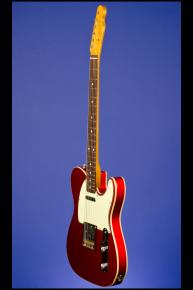An Early Custom Color Fender Japan Telecaster Custom.
1986 Fender (Japan) Telecaster Custom '62.
This custom color early Japanese reissue Telecaster Custom weighs just 7.70 lbs. Single-bound solid alder body. One-piece maple neck with a nut width of 1 11/16 inches, a scale length of 25 1/2 inches, a typical '62 medium profile and a "slab-rosewood" fretboard with 21 frets and white dot position markers. Headstock decal with "Fender" 'spaghetti' logo in silver with black trim and "TELECASTER" in black beneath. Individual vintage-style "no-name" Fender [Kluson] Deluxe tuners with oval metal buttons. Single "butterfly" string tree. Four-bolt neck plate with "Fender" stamped between the top two screws. "Made in Japan" stamped on the back of the neck near the heel. Two hot single-coil pickups: one plain metal-cover pickup at neck with an output of 7.76k and one black six-polepiece pickup angled in bridgeplate with an output of 7.94k. Three-layer white/black/white plastic pickguard with eight screws. Two controls (one volume, one tone) plus three-way selector switch with 'top-hat' tip, all on metal plate adjoining pickguard. Chrome knobs with flat tops and knurled sides. Fender combined bridge/tailpiece with three individually adjustable brass saddles. The tailpiece is stamped with the serial number "A068357". There is one tiny indentation (smaller than a match-head) on the treble side of the body which is all that prevents this guitar from being mint - so we shall conservatively give a near mint (9.25) condition rating. Housed in the original G & G three latch rectangular tweed hardshell case with brown leather ends and red plush lining (9.25)
"In 1984 on the other side of the world, the new Fender Japan operation was busy adding new models to its Vintage reissue series. This time the magnifying glass was trained on a wider portion of Fender history. The earliest style of P-Bass was examined for the '51 Precision Bass and a little binding practice resulted in the '62 Custom Telecaster…
at the end of January 1985, almost exactly 20 years after acquiring it, CBS confirmed that it would sell Fender to ten "employees and foreign distributors," led by Bill Schultz… The problems Schultz and his team faced were legion. Probably the most immediate was the fact that the Fullerton factories were not included in the deal, and so US production stopped in February 1985… The Japanese operation became Fender's lifeline, providing much-needed product to a company that still had no US factory. Around 80 per cent of the guitars that Fender US sold from late 1984 to mid 1986 were made in Japan. All the guitars in Fender;s 1985 catalog were made in Japan, including the new Contemporary Stratocasters and Telecasters…"
We have seen several of the Japanese Blue Flower and Pink Paisley Telecasters that were produced from 1984 through 1986. They are wonderful instruments, expertly made and great sounding. Nowadays Fender manufactures its highest quality guitars at its Corona factory in California, USA and manufactures its mid to high quality guitars at its Ensenada factory in Baja California, Mexico. The older and American built Fender guitars are generally the most favoured, but pre-1990 Fender Japan guitars are now highly regarded as well. Fenders built in Ensenada, Mexico since 1990 took over the main export role from the Japanese made Fenders and Japanese Fenders are now manufactured mainly for the Japanese market, with only a small number marked for export.












